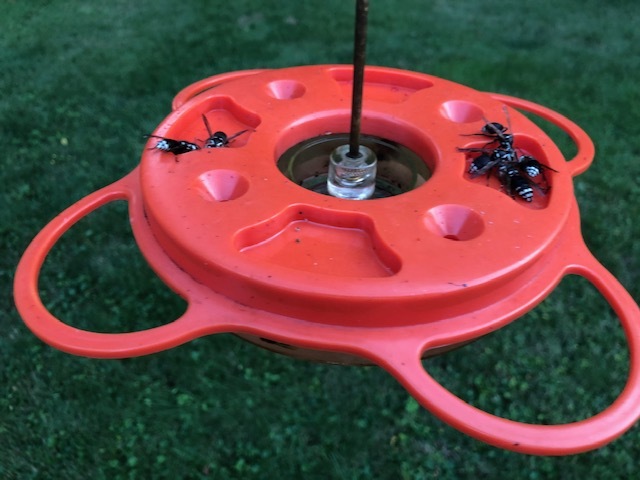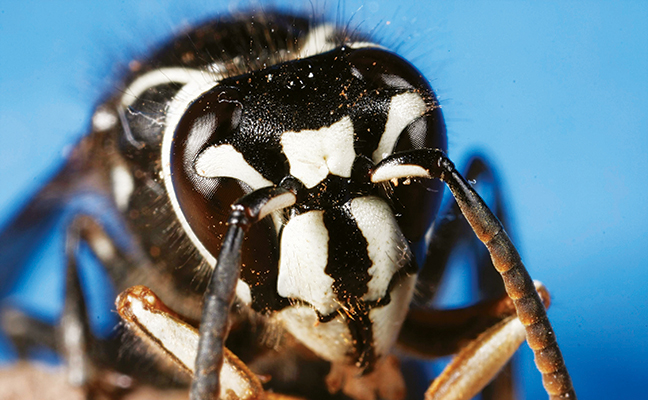
Bald-faced hornets at Senior Editor Diane Sofranec’s house. PHOTO: PMP STAFF
Learn more about the bald-faced hornet (Dolichovespula maculata) through this “interview” with Pest Management Professional (PMP).
PMP: [walks up to a bush where about 3 ft. up is a large, football-shaped nest that appears to be made of grayish paper and several bald-faced hornets flying about, ready to sting] Hello? I’m here to see the queen!
Bald-faced hornet (BH): [a large, black, winged insect with white markings on its face, thorax, legs and abdomen flies out from the bushes] Yes, I am the queen!
PMP: [does a double take] Wait just a minute…I was sent here to meet with a hornet queen, but you’re not a hornet. You’re a yellowjacket! The only hornet in North America is the European hornet, Vespa crabro, and that’s not you!
BFH: Shhh! Keep it down! The workers and drones in the nest don’t know we are actually “aerial yellowjackets,” one of the Dolichovespula genus.
PMP: Well, if they don’t stop trying to sting me, they’re going to find out. Would you please call off your subjects?
BH: [yells to the workers] That’s enough! Dismissed…for now. You know, they are only trying to protect me. That’s what happens when you come within 3 ft. of my home.
PMP: Yes, your nest is quite impressive.
BH: [beams with pride] I’m glad you like it. I know where to find the best rotting wood, which I chew to add my saliva. I use the paste I make to build my nest. You came at a good time, you know. At first, my colony starts out small, but as summer wears on, it eventually grows to between 100 to 400 workers. That’s why my nest is so big.
PMP: Wow! Where do they all come from?
BH: I don’t mean to brag, but I created them! I made a few brood cells in the nest. That’s where I deposited my eggs, and fed the larvae when they hatched. Then they work for me because I am the queen. I’ve given my first brood plenty to do, like build the nest, collect the food, feed the larvae and protect the nest. Because I am the queen!

Photo: Joseph Berger, Bugwood.org
PMP: Are nests always built in the bushes?
BH: Oh no, not always. Look up, and you may see our homes high up in the trees, about 60 ft. above the ground. Or up in the eaves of buildings. We like to feel our homes are protected from the rain and wind. But don’t get too close! If anyone comes within 3 ft., my subjects will protect the colony. They have their orders, and they will attack.
PMP: [checking neck and arms for stings] Uh, yeah I know! I hear bald-faced hornets’ venom makes stings hurt, itch and swell for about 24 hours.
BH: Well, we have to protect this exquisite nest somehow. But we’ll only be here for the year. We never, ever reuse our nests year after year. We’re not peasants!
PMP: So you make everyone move out at the end of the year?
BH: Ahem, I don’t make them move out; they all die off after the first hard frost. The colony lives one year, that’s it. But we queens are lucky! In the fall, males and new queens are produced, leave the nest, and mate. When a queen is fertilized, she overwinters under bark or in hollow trees, in rock piles, and in a building’s walls and attic. Then, she emerges in the spring to build her beautiful nest and establish a colony. It’s quite lovely, actually!
PMP: Oh, so you’re only a nuisance until the weather turns cold?
BH: [bristles] Nuisance? How dare you! I don’t understand why you would want to harm us. We’re pollinators, you know.
PMP: You are?
BH: Oh yes. Typically, we feast on flies, yellowjackets and other insects. But when workers have fewer larvae to feed, they seek out nectar.
PMP: So, you really are pollinators! And you eat unwanted insects, which helps reduce their populations.
BH: Correct! So please, leave our nests alone, especially when they are up high and away from heavily populated areas. We’ll be gone within the year, you have my word.
PMP: Hmm, if your workers are buzzing around a nest that was built where people are, you can’t blame pest management professionals for, uh, taking it out one night, when the majority of your workers are in the nest and are not as active.
BH: [gasps] That’s enough! Don’t make me summon my minions. This interview is over!
Leave A Comment